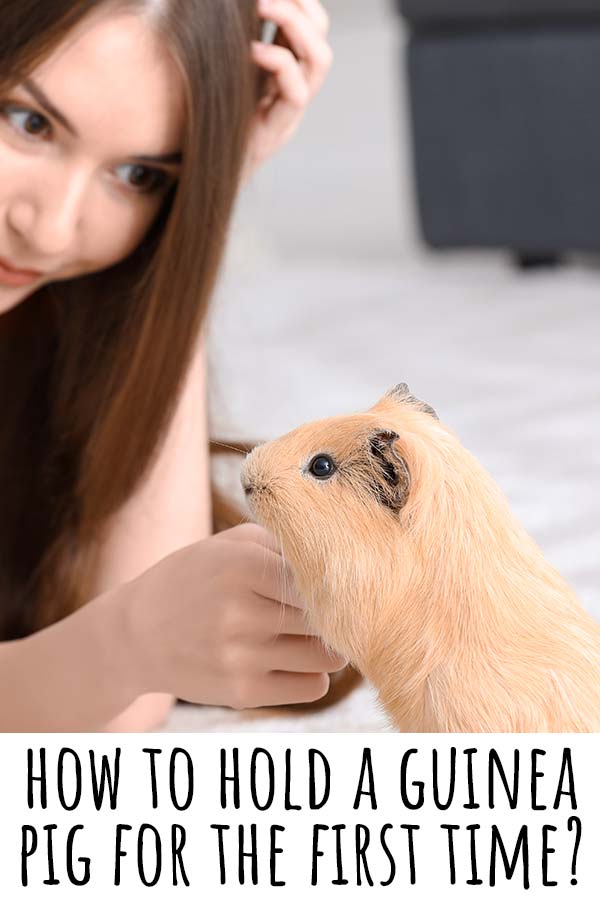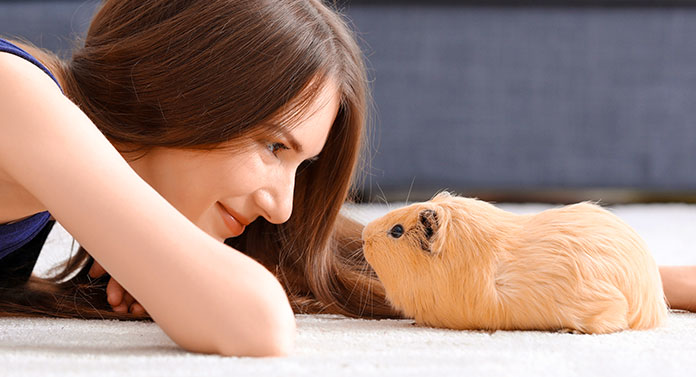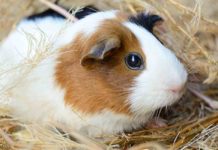It’s ok to not instinctively know how to hold a guinea pig for the first time.
Always pick up a guinea pig by approaching them sideways on, and scooping them up with both hands.
Keep one hand under their butt while you hold them, and hold them securely but not tightly to your chest.
Look and listen for body language and noises which tell you they’re either happy, or unhappy.
In this article, we have lots of tips to make sure you’re confidently enjoying cuddles together in no time!
How To Hold A Guinea Pig
Guinea pigs are typically gentle and easy to handle pets, but knowing how to pick them up correctly before you try can really improve your chances of getting off on the right paw.
Guinea pigs are descended from prey species, which means their survival in the wild would depend upon a healthy distrust of everything bigger than them.
Obviously, you’re not planning on eating them, but they don’t know that yet.
So the first step towards handling a guinea pig is demonstrating to them that you’re friendly.

How To Handle A Guinea Pig – Proving You Come In Peace
We know you’re impatient to start interacting with your cute new cavy, but it’s important to allow them a few days to settle in first.
Make sure their new habitat has cubby holes and enclosed beds – guinea pigs love having places to hide.
Providing hideaways for them while they adjust to their new home reduces stress, and makes them more receptive to getting to know you.
Whilst they’re settling in, chat softly to them while you change their water and food, so they get used to the sound of your voice.
Once they’re confidently exploring their hutch and treating the whole space like their own, it’s safe to start making your move.
Slowly Does It…
The easiest, most convincing way to win round a new guinea pig is with food.
Dandelion leaves and wild strawberry leaves from the yard are good, if you have a ready supply. And parsley and watercress are usually irresistible store bought options.
On day one, just put a leaf or two into their food bowl several times during the day.
On day two, put your offering right next to your new guinea pig.
By day three, try holding the food out so that they have to take it from your hand.
On day four, you can try picking them up, so they have to eat their snack while you’re holding them.
Don’t be tempted to overdo it – put them right back once the snack is gone. You’ve got plenty of time to build up to longer cuddles later.
Now let’s look at the practical aspects of that first hug.
Do’s and Don’ts of Holding A Guinea Pig
- Do approach them sideways on with tasty treats to show that you’re a friend. Crouch if you have to, rather than stoop over them from above.
- Don’t swoop down suddenly from above. Guinea pigs have a remarkably wide field of vision, and their eyes are particularly adapted to spot predators approaching from above.
- Do pick them up by sliding one hand under their belly, and the other under their butt. Keep their butt supported at all times to protect their spine, and use your other hand to hold them close to your body.
- Don’t let them dangle by their armpits, or squeeze them.
- Do wrap them in a towel with their head poking out if you’re nervous, or if there’s an urgent need to examine a guinea pig that isn’t used to being handled yet.
- Don’t force a new guinea pig pet to be handled more than they’re happy with.
- Do learn the signals guinea pigs give when they’re happy, uncomfortable, or just ready to be put down.
- Do let children handle guinea pigs by sitting the child on the floor with a towel over their lap, and putting the guinea pig on the towel.
- Don’t let young children carry guinea pigs around – they’re inclined to drop them if they get nibbled or scratched by a toenail, which can result in fractures and other injuries.
Interpreting How Your Guinea Pig Feels About Being Held
Guinea pigs are usually quite easy to handle. They tend to be sociable and curious by nature, and once they’re used to being held they interact quite enthusiastically with their human family.
Bear in mind that even guinea pigs who are used to being held are likely to wriggle at the point of being picked up.
This is like a survival reflex – they just can’t help it! So be ready to meet them with calm and confidence, and never try to pick them up singled handed, or when you’re also juggling something else in your hands.
Guinea pigs rarely bite, but they might occasionally deliver a little nibble.
One of my guinea pigs gives just about everyone a little nibble the first time they pick her up, presumably to check whether they’re made of food.
And when she’s done being cuddled, she nips again to signal that she’d like to be put down.
Most guinea pigs will let you know when they’re ready to be put down, by nibbling your hand, tugging your sleeve, or starting to wriggle about.
Next up, here are some other signals to listen for, to let you know how your pig feels about being held.
Signals that your guinea pigs is uncomfortable
Guinea pigs make an impressive variety of noises, and in time you’ll become familiar with them all – especially the long “wheeeeeek” when they realise it’s dinner time!
But these are the sounds guinea pigs use to signal when they are feeling scared, uncomfortable, or threatened:
If you cavy makes any of these noises while you’re attempting to handle him, just leave your treats with him and back off until another day:
- A “tutt-tutt-tutt” noise (called chuttering), followed by a whine. If you’re not sure whether you’re recognizing this sound correctly, look at how your other guinea pigs react to it. If they freeze on the spot, it’s because they’ve heard the pig in your hands emit a warning that something unpleasant is happening to them.
- Protest squeaks. These are shorter and more shrill than the excited wheeking of a guinea pig anticipating food. Don’t worry if you can’t tell the difference at first.
- Chirping.
- Tooth chattering. Guinea pigs chatter their teeth in response to threats or perceived threats, and it usually means they’re ready to bite if you don’t back off!
How Often Should You Handle Guinea Pigs?
The more effort you put into interacting with your guinea pigs, the more engagement and affection you’ll get back.
Try to handle them every day. Experiment with bringing them different edible gifts, to make it fun for both of you.
Getting guinea pigs used to being handled is vital for looking after them.
For a start it makes brushing their coats and trimming their nails easier.
Handling is also the best way to spot health problems quickly. Guinea pigs are a prey species, so they instinctively hide pain and symptoms of illness for as long as possible. Once they start “acting” ill, they tend to deteriorate very quickly.
A guinea pig that is accustomed to being handled is also easier to treat if they do get sick.
How To Hold A Guinea Pig For The First Time – Summary
Holding a new pet guinea pig for the first time is an exciting moment.
The key is not to rush into it, and give your cavy a chance to settle in and get to know you first.
Pick them up calmly and confidently, with one hand supporting their bottom, and the other under their belly.
Then keep them close to your chest or on your lap.
You’ll be enjoying long cuddles in no time, and these will be a great way to monitor your pet’s overall welfare too!
Readers Also Liked
- Do Guinea Pigs Have Tails?
- What Fruits Can Guinea Pigs Eat?
References
Donnelly & Brown. Guinea pig and chinchilla care and husbandry. Veterinary Clinics Exotic Animal Practice. 2004.
Richardson. Care of Guinea Pigs. Veterinary Nursing Journal. 2011.
Zeng et al. The development of eye shape and the origin of lower field myopia in the guinea pig eye. Vision Research. 2013.















